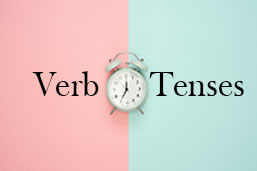
Although there are many verb tenses you can use in the English language, only three tenses are used in academic writing 98% of the time. The most commonly used ones are the present simple, past simple, and present perfect tenses. In this guide, you will learn about the three key tenses in detail and how to use them appropriately in accordance with academia. Additionally, examples will be included in order to provide a more profound understanding of shaping sentences correctly.
Definition: Verb tenses
While there are many verb tenses, academic writing primarily employs the present simple, past simple, and present perfect. They serve as grammatical devices that indicate the scope of events that are being portrayed in a written document. Verb tense choice significantly affects the academic tone of a paper, e.g., abstracts and introductions often require multiple tenses, as they set up the background (past tense), explain the current state of knowledge (present tense), and outline the aim of research (root form).
Verb tenses: Functions
By using the correct verb tense, you will be able to clearly express the time relationship among the ideas presented. When choosing verb tenses to use in academic writing, you should aim for consistency, clarity, and simplicity. Thus, stick to the present simple, past simple, and present perfect tense. The table below depicts the functions of each essential tense, along with examples.
| Tense | Function | Example |
| Present simple | Facts, paraphrasing, general statements, conclusions. | The theory of relativity explains the relationship between space and time. |
| Past simple | Report findings, describe methods or data of a prior study. | In 1990, the government implemented new policies to address the growing use of urban sprawl. |
| Summarizing, describing, or emphasizing relevance of previous work. | Data has shown that early childhood education has lasting benefits for cognitive development. |
Verb tenses: Examples
In academic writing, the most commonly used verb tenses are the present simple, past simple, and present perfect tense. Let’s look at each of these regular verb tenses in detail.
The present simple is commonly used to express general truths, define concepts, or describe the current state of knowledge. It is the most used verb tense in academic English as it serves a specific purpose in presenting research, discussing findings, and establishing context.
The past simple verb tense is used to describe specific methods, procedures, or findings from completed research. The simple past verb forms are particularly useful when reporting what was done or observed in previous studies.
The present perfect is employed to connect past research with the present by highlighting how past studies have contributed to current understanding or how they are relevant to ongoing actions or research. It helps establish the continuity of knowledge and contextualize previous work in relation to current study.
Using other verb tenses
sing a range of tenses to convey different meanings or temporal context is also acceptable in academic writing, as long as you do so consistently and purposefully. While the previous three tenses are the most common, you can use other tense forms, like the future simple, sparingly and only when necessary. Additionally, modal verbs can express degrees of possibility or uncertainty, helping to avoid implying absolute certainty about future outcomes. Tense verbs, on the other hand, should be used carefully to indicate actions occurring within specific periods of time, ensuring clarity in your writing.
Future simple
Future simple can be used to outline future actions or research, or to state hypotheses or goals. However, many academics refrain from using this tense due to its implication of certainty. You can prevent its usage by using verbs like “assume,” “expects,” or “predict.” Rather than making concrete statements, verbs or modal verbs such as “can,” “could,” or “may” can be quite helpful in avoiding this issue, as they maintain a more formal and neutral tone. Another solution is using passive constructions to refrain from overusing simple future.
Continuous tenses
Present, past, and future continuous tenses, which rely on auxiliary verbs to indicate ongoing actions within specific time periods, are generally avoided in academic writing due to their informal tone. Using tenses, such as present simple or present perfect, is highly recommended as a substitute.
numerous advantages for Canadian students:
- ✓ 3D live preview of your configuration
- ✓ Free express delivery for every order
- ✓ High-quality bindings with individual embossing

FAQs
In academic writing, a verb tense is a grammatical tool used to convey the timing of events, indicate the status of research, and structure ideas clearly.
Yes, as an academic writer you can mix multiple tenses in a sentence or paragraph; you just need to make sure they are used appropriately for the context. If two types of actions occur within the same time period, you should use the same tense for all of them. However, shifts in verb tense are acceptable when actions take place in different periods of time or when indicating indeterminate time. Additionally, ensure that any verbal phrases maintain consistency with the tense used in the main clause to avoid confusion.
The choice between present and past tense depends on the context. Use present tense when describing established knowledge or ongoing theories; when discussing the content of the current study; when describing what authors argue or state in their publications.
Use past tense when referring to completed findings of past studies; when describing the methodology, procedures, or results of your own research; when reporting on historical events or when the timing of the action is specified.
The most commonly used tense in academic English is the present simple.
